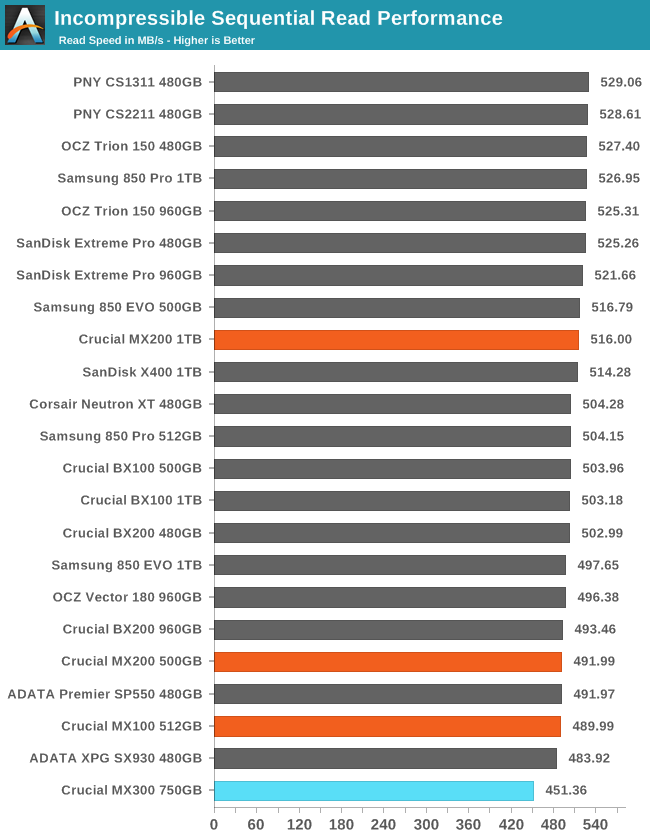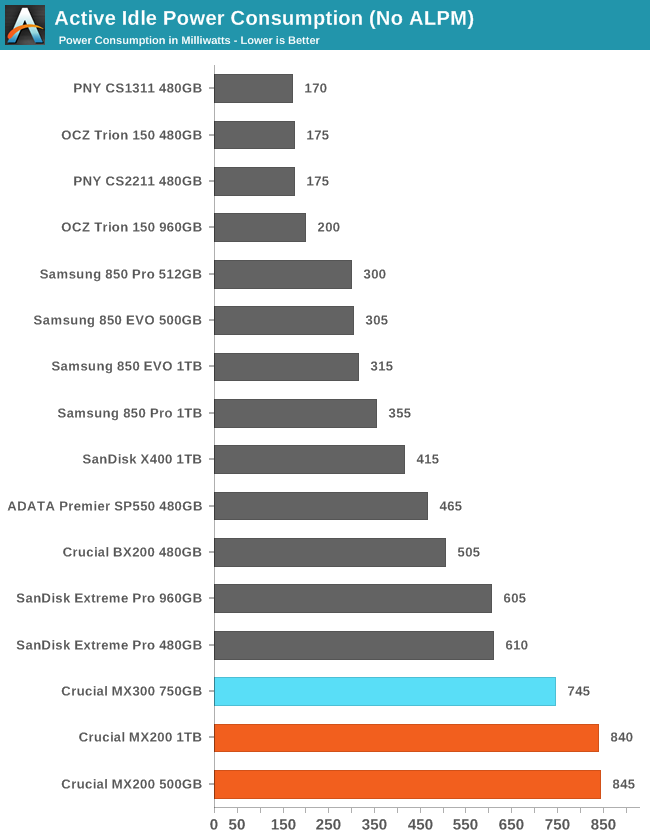The Crucial MX300 750GB SSD Review: Micron's 3D NAND Arrives
by Billy Tallis on June 14, 2016 9:00 AM ESTATTO
ATTO's Disk Benchmark is a quick and easy freeware tool to measure drive performance across various transfer sizes.
 |
|||||||||
The ATTO performance plot shows that small reads are slow but performance is reasonably stable for large transfers, albeit a little slower than the MX200.
AS-SSD
AS-SSD is another quick and free benchmark tool. It uses incompressible data for all of its tests, making it an easy way to keep an eye on which drives are relying on transparent data compression. The short duration of the test makes it a decent indicator of peak drive performance.


AS-SSD shows the MX300 read speed as suffering slightly, but the (SLC cached) write speed as perfectly normal.
Idle Power Consumption
Since the ATSB tests based on real-world usage cut idle times short to 25ms, their power consumption scores paint an inaccurate picture of the relative suitability of drives for mobile use. During real-world client use, a solid state drive will spend far more time idle than actively processing commands. Our testbed doesn't support the deepest DevSlp power saving mode that SATA drives can implement, but we can measure the power usage in the intermediate slumber state where both the host and device ends of the SATA link enter a low-power state and the drive is free to engage its internal power savings measures.
We also report the drive's idle power consumption while the SATA link is active and not in any power saving state. Drives are required to be able to wake from the slumber state in under 10 milliseconds, but that still leaves plenty of room for them to add latency to a burst of I/O. Because of this, many desktops default to either not using SATA Aggressive Link Power Management (ALPM) at all or to only enable it partially without making use of the device-initiated power management (DIPM) capability. Additionally, SATA Hot-Swap is incompatible with the use of DIPM, so our SSD testbed usually has DIPM turned off during performance testing.


Marvell's latest controller allows for great slumber power savings, but Micron needs to work on improving active idle power draw.










85 Comments
View All Comments
Gondalf - Wednesday, June 15, 2016 - link
Good point. The real story the have not even read the article, or maybe there is a lot of marketing guys at work here.After all Samsung has shipped for two years 3D SSD drivers in nearly money loss cause the low yields of their manufacturing process on a 3D structure.
icrf - Tuesday, June 14, 2016 - link
What is the expected performance of the 3D MLC NVMe SSD, or is that too many variables different to tell from here? I'm curious if the charge trap/floating gate decision affected performance.jabber - Tuesday, June 14, 2016 - link
I'm taking it that Crucial have given up on SSD R&D? After all each Crucial SSD post BX100 (what a great SSD) just gets slower than the previous.JoeyJoJo123 - Tuesday, June 14, 2016 - link
If Crucial has "given up" then what does that speak for Toshiba and other manufacturers that STILL haven't done 3D stacked MLC NAND?Samsung led the innovation 2 years ago and now their first competitor just showed up.
vladx - Tuesday, June 14, 2016 - link
Sandisk X400 seems to be the king of budget SSDs, paying 80USD more for 850 EVO is definitely not worth it imo.Meteor2 - Tuesday, June 14, 2016 - link
Can't dispute that.Lolimaster - Saturday, June 18, 2016 - link
They're not.Unless you move tons of data per day with more than 1 pci-e nvme drive there's no difference between sata and pcie ssd's. PCie ssd uses more power and produces more heat.
Communism - Tuesday, June 14, 2016 - link
With the advent of PCIE 3.0 X4 NAND drives a while ago, the whole SATAIII segment of SSDs are essentially obsolete. The lack of significant competition in the PCIE3.0 X4 NAND drives bringing down prices quickly is disconcerting.The only COGS difference between PCIE3.0 X4 NAND drives and SATAIII drives is the controller, which doesn't actually cost much at all.
Buying into SATAIII SSDs at this point in time simply is a bad idea comparatively.
TheinsanegamerN - Tuesday, June 14, 2016 - link
Sara is hardly obsolete. Pcie m2 drives still only hit 512gb vs the 2tb sata drives, still run hotter, and don't offer much but a faster boot time. Day to day performance between sata and pice is nil unless you are moving hundreds of gigs of data per day onto/off of the drive.Until m.2 is cheaper, cooler, and the same capacity as sata, sata isn't going anywhere.
vladx - Tuesday, June 14, 2016 - link
Actually, NVMe drives boot slower because of additional drivers needed to be loaded.